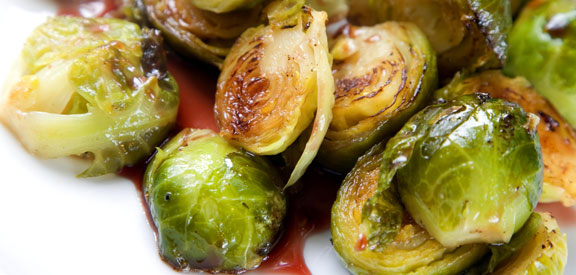How to pick, store and prepare Brussels Sprouts
If Brussels sprouts have been off your radar since elementary school, perhaps it’s time to give these free-radical fighters a flavor makeover. Sure, some things are better left in the past, but we double-dare you to give these gems another chance.

Brussels sprouts have grown up a bit in the last few decades – and your taste buds likely have too. Restaurant chefs are using the earthy vegetable in everything from fried appetizers to fancy main dishes. If your mother you to choke down Brussels sprouts as a child, we understand your aversion to them, but maybe it’s time you give this healthful cabbage another go.
The “sprouts” part of the plant are the part you eat – they’re the miniature heads of cabbage that grow along a thick stalk that flowers into a whimsical burst of foliage at the top. The small cabbage buds were first harvested centuries ago in Europe; they grew abundantly in Brussels, Belgium, when they became poplar, and the name stuck.
Brussels sprouts are available year round, but because they grow best in cool or lightly frosty weather, they are often harvested – and more flavorful – from autumn to early spring. Smaller sprouts (about 1 to 1 ½ inches in diameter) are most desirable. They’re tender and less pungent than larger sprouts. Look for sprouts with firm, dense heads and bright green, compact leaves. Avoid sprouts with yellow leaves or holes – signs of insect damage. To store, simply refrigerate unwashed sprouts in a plastic bag for up to three days.
In addition to great taste and dinner-time versatility, Brussels sprouts are an excellent source of vitamins, fiber, iron, and disease-fighting compounds. And that’s the best type of vegetable a mom could ever serve.
Your guide to slicing and sautéing sprouts:
1. Peel off a few of the outer lower leaves to pare each sprout down to a tight, compact had and to expose more of the stalk.
2. Cut the stems close to the bottom leaves, but not so close that the leaves fall off.
Option: If you prefer to keep Brussels sprouts whole, cut an X about ½ inch deep across the stem. This helps the sprout cook evenly and tenderizes the toughest part.
3. If smaller sprouts are desired or if sprouts need to be cut to uniform size, cut them lengthwise across the stem into halves or quarters.
4. Make a ½ – inch cut into the stem of any halved sprouts so the stem end cooks evenly.
5. Sauté sprouts in a nonstick pan in al little olive oil or low-sodium broth along with other flavorful ingredients such as garlic and onions. Cook until the sprouts are tender and lightly browned, turning occasionally, 10 to 15 minutes.
Nutritional Bonus: Glucosinolates (nutrients that are crucial to the development of several cancer risk-reducing substances) are found largely in Brussels sprouts, as they are in all cruciferous vegetables like greens, cabbage, cauliflower and broccoli. However, Brussels sprouts contain a special combination of glucosinolates that are believed to be extra beneficial to the development of cancer risk-reducing compounds in the body.

